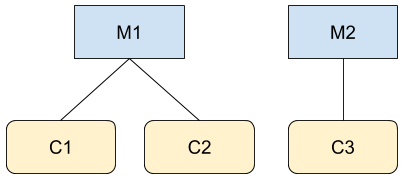คุณสามารถแสดงรายชื่อลูกค้าที่เข้าถึงได้ด้วยเมธอด
ListAccessibleCustomers
ใน CustomerService อย่างไรก็ตาม คุณต้องทำความเข้าใจว่าลูกค้าใดบ้างที่แสดงในคำขอประเภทนี้
การแสดงลูกค้าที่เข้าถึงได้เป็นหนึ่งในคำขอไม่กี่รายการใน Google Ads API ที่ไม่จำเป็นต้องระบุรหัสลูกค้าในคำขอ และคำขอจะละเว้น login-customer-id ที่ระบุ
รายชื่อลูกค้าที่ได้จะอิงตามข้อมูลเข้าสู่ระบบ OAuth
คำขอจะแสดงรายการบัญชีทั้งหมดที่คุณดำเนินการได้โดยตรงตามข้อมูลเข้าสู่ระบบปัจจุบัน ซึ่งอาจไม่รวมบัญชีทั้งหมดภายในลำดับชั้นบัญชี แต่จะรวมเฉพาะบัญชีที่เพิ่มผู้ใช้ที่ได้รับการตรวจสอบสิทธิ์ของคุณพร้อมสิทธิ์ผู้ดูแลระบบหรือสิทธิ์อื่นๆ ในบัญชี

สมมติว่าคุณคือผู้ใช้ A ซึ่งเป็นผู้ดูแลระบบของ M1 และ C3 ในลำดับชั้น 2 ระดับที่แสดงในรูป หากคุณจะเรียกใช้ Google Ads API เช่น GoogleAdsService คุณจะเข้าถึงข้อมูลของบัญชี M1, C1, C2 และ C3 ได้ อย่างไรก็ตาม การเรียกไปยัง
CustomerService.ListAccessibleCustomers
จะแสดงผลเฉพาะ M1 และ C3 เนื่องจากเป็นบัญชีเดียวที่ผู้ใช้ A
มีสิทธิ์เข้าถึงโดยตรง
ตัวอย่างโค้ดที่แสดงการใช้เมธอด
CustomerService.ListAccessibleCustomers
มีดังนี้
Java
private void runExample(GoogleAdsClient client) { // Optional: Change credentials to use a different refresh token, to retrieve customers // available for a specific user. // // UserCredentials credentials = // UserCredentials.newBuilder() // .setClientId("INSERT_OAUTH_CLIENT_ID") // .setClientSecret("INSERT_OAUTH_CLIENT_SECRET") // .setRefreshToken("INSERT_REFRESH_TOKEN") // .build(); // // client = client.toBuilder().setCredentials(credentials).build(); try (CustomerServiceClient customerService = client.getLatestVersion().createCustomerServiceClient()) { ListAccessibleCustomersResponse response = customerService.listAccessibleCustomers( ListAccessibleCustomersRequest.newBuilder().build()); System.out.printf("Total results: %d%n", response.getResourceNamesCount()); for (String customerResourceName : response.getResourceNamesList()) { System.out.printf("Customer resource name: %s%n", customerResourceName); } } }
C#
public void Run(GoogleAdsClient client) { // Get the CustomerService. CustomerServiceClient customerService = client.GetService(Services.V22.CustomerService); try { // Retrieve the list of customer resources. string[] customerResourceNames = customerService.ListAccessibleCustomers(); // Display the result. foreach (string customerResourceName in customerResourceNames) { Console.WriteLine( $"Found customer with resource name = '{customerResourceName}'."); } } catch (GoogleAdsException e) { Console.WriteLine("Failure:"); Console.WriteLine($"Message: {e.Message}"); Console.WriteLine($"Failure: {e.Failure}"); Console.WriteLine($"Request ID: {e.RequestId}"); throw; } }
PHP
public static function runExample(GoogleAdsClient $googleAdsClient) { $customerServiceClient = $googleAdsClient->getCustomerServiceClient(); // Issues a request for listing all accessible customers. $accessibleCustomers = $customerServiceClient->listAccessibleCustomers(new ListAccessibleCustomersRequest()); print 'Total results: ' . count($accessibleCustomers->getResourceNames()) . PHP_EOL; // Iterates over all accessible customers' resource names and prints them. foreach ($accessibleCustomers->getResourceNames() as $resourceName) { /** @var string $resourceName */ printf("Customer resource name: '%s'%s", $resourceName, PHP_EOL); } }
Python
def main(client: GoogleAdsClient) -> None: customer_service: CustomerServiceClient = client.get_service( "CustomerService" ) accessible_customers: ListAccessibleCustomersResponse = ( customer_service.list_accessible_customers() ) result_total: int = len(accessible_customers.resource_names) print(f"Total results: {result_total}") resource_names: List[str] = accessible_customers.resource_names for resource_name in resource_names: # resource_name is implicitly str print(f'Customer resource name: "{resource_name}"')
Ruby
def list_accessible_customers() # GoogleAdsClient will read a config file from # ENV['HOME']/google_ads_config.rb when called without parameters client = Google::Ads::GoogleAds::GoogleAdsClient.new accessible_customers = client.service.customer.list_accessible_customers().resource_names accessible_customers.each do |resource_name| puts "Customer resource name: #{resource_name}" end end
Perl
sub list_accessible_customers { my ($api_client) = @_; my $list_accessible_customers_response = $api_client->CustomerService()->list_accessible_customers(); printf "Total results: %d.\n", scalar @{$list_accessible_customers_response->{resourceNames}}; foreach my $resource_name (@{$list_accessible_customers_response->{resourceNames}}) { printf "Customer resource name: '%s'.\n", $resource_name; } return 1; }
curl
# Returns the resource names of customers directly accessible by the user # authenticating the call. # # Variables: # API_VERSION, # DEVELOPER_TOKEN, # OAUTH2_ACCESS_TOKEN: # See https://developers.google.com/google-ads/api/rest/auth#request_headers # for details. # curl -f --request GET \ "https://googleads.googleapis.com/v${API_VERSION}/customers:listAccessibleCustomers" \ --header "Content-Type: application/json" \ --header "developer-token: ${DEVELOPER_TOKEN}" \ --header "Authorization: Bearer ${OAUTH2_ACCESS_TOKEN}" \
แสดงรายการบัญชีที่ยกเลิก
Google Ads API ไม่มีวิธีโดยตรงในการแสดงบัญชีที่ยกเลิกภายใต้บัญชีดูแลจัดการ อย่างไรก็ตาม คุณสามารถใช้ทางแก้ต่อไปนี้เพื่อดึงข้อมูล รายการนี้ได้
ดึงข้อมูลรายการลิงก์
ACTIVEโดยใช้แหล่งข้อมูลcustomer_client_linkและสร้างรายชื่อลูกค้าโดยใช้ฟิลด์customer_client_link.client_customerSELECT customer_client_link.client_customer, customer_client_link.status FROM customer_client_link WHERE customer_client_link.status = ACTIVEเรียกข้อมูลรายการบัญชี
ENABLEDโดยใช้ทรัพยากรcustomer_clientSELECT customer_client.id, customer_client.descriptive_name FROM customer_clientความแตกต่างระหว่าง 2 รายการนี้จะทำให้คุณได้รายการบัญชีที่ถูกยกเลิก

